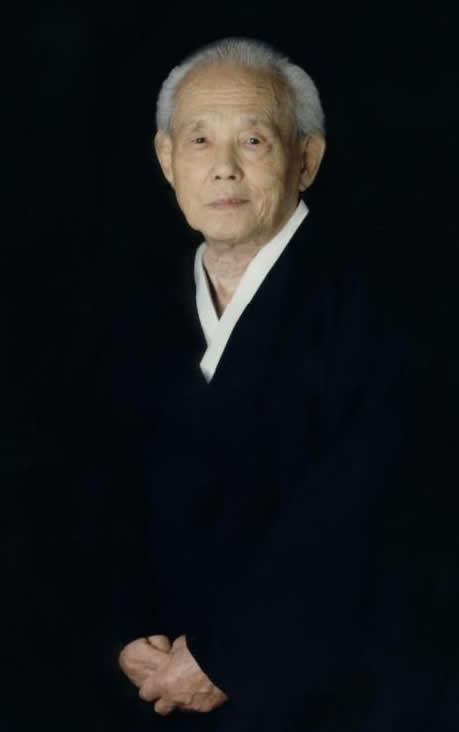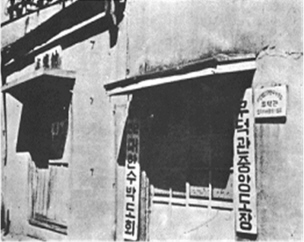|
By Master C.
Terrigno - 6th Dan
Editor - Tang Soo Do World
|
Great
Grandmaster
Hwang Kee
Founder
of
Tang Soo Do (Soo Bahk Do)
Moo Duk Kwan
November 9, 1914 - July 14, 2002

|
|
|
|
Born November 9, 1914 in Jang Dan, Kyong Ki
province, Grandmaster Kee Hwang was destined to become a part of
martial arts history, alongside names such as Jigoro Kano (1860 -
1938, founder of Judo), Gichin Funakoshi (1868
- 1957, father of modern karate) and Morihei Ueshiba (1883 - 1969,
founder of Aikido).
His father was a scholar who was awarded a special
recognition by the last King of the Yi Dynasty. Before his son's
birth he dreamt of a bright star (Sam Tae Song) and named the
Grandmaster "Tae Nam", meaning "Starboy".
Often referred to as a "martial arts prodigy" the Grandmaster was widely acknowledged as a gifted martial artist,
due in large part to his inquisitive nature and
scholarly approach to the development and refinement of his art.
It began at the age of seven, when he attended a traditional holiday festival
and witnessed a
confrontation where one man defeated seven or eight
attackers using various martial techniques.
He followed the man to his home and a few days
later began to observe the man practicing from a distance and
imitated what he saw. Later, he approached the man and asked to be
taught the techniques he witnessed. The man refused because of his
young age. This did not end the Kwan Jang Nim's interest.
He continued to observe the man training from afar, and practiced
what he saw.
The Moo Duk Kwan Story
The Japanese
Occupation - 1910 to 1945
It was a difficult time when the only martial arts
allowed in Korea were Kendo and Judo. The Grandmaster
studied and trained on his own from 1921 until 1936. In 1936, while working with the railroad in Manchuria, he was
introduced to a Chinese master, Master Yang with whom he trained
until his return to Seoul in August
of 1937.
In 1939, he began work with the Cho Sun Railway
Bureau. There he had a library with many books on martial arts,
particularly Okinawan Karate. Through the books, he studied this art
which later influenced Tang Soo Do Moo Duk Kwan and is evidenced in
the Pyung Ahn forms as well as Bassai and Kong Sang Kun.
The
Development Period - 1945 - 1960
With the end of Japan's occupation,
the Grandmaster was free to pursue the development of his
art according to his vision. On November 9, 1945 he founded the
Moo Duk Kwan and
named his art Hwa Soo Do (art of the flowering hand).
Unfortunately, it was not immediately popular so
it struggled to gain
and keep students. He later met Won Kuk Lee,
the founder of Chung Do Kwan, whose art was Tang Soo Do.
Lee had trained
in Karate in Japan, was very successful and had
many more students than the Moo Duk Kwan. Because Tang Soo Do had a
more recognizable name, it was better received
by the public. The Grandmaster decided to combine it with his
Hwa Soo Do and what he learned from the Okinawan books.
In 1947
he began teaching his new art of
Tang Soo Do Moo Duk Kwan to
the public.
At the start of the Korean War in 1950 the development of the art was again
disrupted until the war's end in 1953, when the
Kwan Jang Nim returned to Seoul to continue his work. He
leased his first commercial space in 1955 and it grew to be known as the
legendary "Joong Ang Do Jang".
 |
|
|
Joong Ang
Do Jang |
|
As the Moo Duk Kwan's popularity
grew, more dojangs sprang up. The Moo Duk Kwan system was taught in
schools, to the police and the military, both at the Naval & Air
Force Academy of Korea and the Republic Of Korea Air Force Academy
where the Grandmaster taught personally.
In 1957, Tang Soo Do Moo Duk Kwan was
first introduced to U.S. servicemen. Classes were held at the U.S.
8th Army's Trent Gym in Yong San, Seoul. By
1960 it had spread to five other U.S. military bases which led to introduction of Tang Soo Do in the U.S. by returning
servicemen.
1957 was a pivotal year in another
respect. During his research, the Kwan Jang Nim discovered a 300
year-old Korean manuscript called the
"Moo Yei Do Bo Tong Ji"
that documented Korean martial techniques known as Soo Bahk. This
was a fortunate find as his vision was to have a truly Korean
martial art and a traditional Korean martial arts organization. In Korea at that time there were only
five original Kwans -
Moo Duk Kwan (Hwang Kee),
Yeon Moo
Kwan (Yun, Kwei Byong),
YMCA Kwon Bup Bu (Lee, Nam Suk),
Chung Do Kwan (Shon, Duk Song),
Song Moo Kwan (No,
Byong Jik).
Ji Do Kwan, an offshoot of the Yeon
Moo Kwan merged with the Moo Duk Kwan and on June 30, 1960 they were
officially registered as the
Korean Soo Bahk Do Moo Duk Kwan
Association, with Grandmaster Hwang Kee as its head.
More
Difficult Times - 1961 to 1966
1961 marked the beginning of another
round of
hardship for the Moo Duk Kwan. On May 16th, a military revolution
led by Lt. General Chong Hee Park took place. The Grandmaster was
removed as instructor for the ROK Air Force base and the national
police, and was prohibited from publishing his monthly publication,
Moo Yei Si Bo. Between 1961 and 1965, operation of the the
Association became very difficult as the government exercised great
political control over it.
In 1964 the Korean Tae Soo Do
Association was formed, which in 1965 became the Korean Tae Kwon Do
Association. Due to its political influences, the Tae
Kwon Do group, led by its second President, General Choi, Hong Hee,
tried to unify it with the Korean Soo Bahk Do Association. Kwan Jang
Nim's organization was the largest of any martial arts system in
Korea at the time. Grandmaster Hwang Kee agreed to discuss
unification, but when it became clear that the move was designed
to gain control over his organization, he ultimately refused. The
result was a weakening of the Moo Duk Kwan as the Tae Kwon Do
movement grew in strength, absorbing many Moo Duk Kwan members in
the process.
In 1965 and again in 1966, the Kwan
Jang Nim won two legal battles that would allow him to run his
organization without interference and thereby work to rebuild his
organization. As a testament to the Grandmaster's perseverance in
the face of
great adversity, Tang Soo Do (Soo Bahk Do) is today practiced in
45 countries around the world.
1970 - Grandmaster
Hwang Kee published
his "Soo Bahk Do Dae Kahm" (Korean language)
1978 - "Tang Soo Do (Soo Bahk Do)" (English version) was
published.
1989 - He was voted Black Belt Magazine's Man of the Year.
1995 - "The History of the Moo Duk
Kwan" was published
**
Source data from the
"The History of the Moo Duk Kwan" - 1995.
For more on the Moo Duk Kwan, visit
www.worldmoodukkwan.com
|